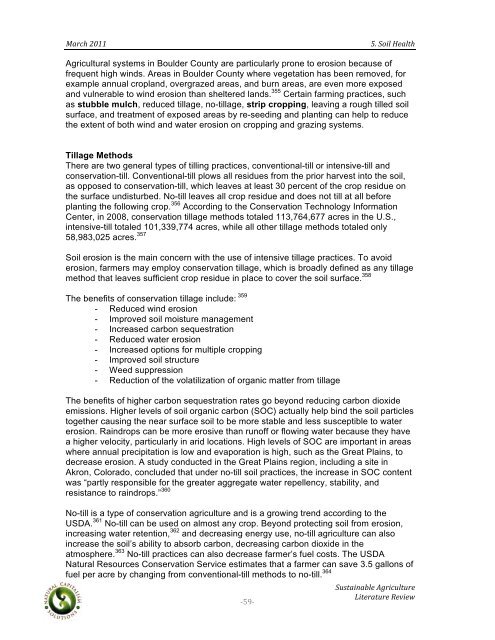Sustainable Agriculture Literature Review - Boulder County
Sustainable Agriculture Literature Review - Boulder County
Sustainable Agriculture Literature Review - Boulder County
Create successful ePaper yourself
Turn your PDF publications into a flip-book with our unique Google optimized e-Paper software.
! !!<br />
"#$%&!'())!! !!!!!!!!!!!!!!!!!!!!!!!!!!!!!!!!!!!!!!!!!!!!!!!!!!!!!!!!!!!!!!!!!!!!!!!!!*+!,-./!01#/2&!<br />
Agricultural systems in <strong>Boulder</strong> <strong>County</strong> are particularly prone to erosion because of<br />
frequent high winds. Areas in <strong>Boulder</strong> <strong>County</strong> where vegetation has been removed, for<br />
example annual cropland, overgrazed areas, and burn areas, are even more exposed<br />
and vulnerable to wind erosion than sheltered lands. 355 Certain farming practices, such<br />
as stubble mulch, reduced tillage, no-tillage, strip cropping, leaving a rough tilled soil<br />
surface, and treatment of exposed areas by re-seeding and planting can help to reduce<br />
the extent of both wind and water erosion on cropping and grazing systems.<br />
Tillage Methods<br />
There are two general types of tilling practices, conventional-till or intensive-till and<br />
conservation-till. Conventional-till plows all residues from the prior harvest into the soil,<br />
as opposed to conservation-till, which leaves at least 30 percent of the crop residue on<br />
the surface undisturbed. No-till leaves all crop residue and does not till at all before<br />
planting the following crop. 356 According to the Conservation Technology Information<br />
Center, in 2008, conservation tillage methods totaled 113,764,677 acres in the U.S.,<br />
intensive-till totaled 101,339,774 acres, while all other tillage methods totaled only<br />
58,983,025 acres. 357<br />
Soil erosion is the main concern with the use of intensive tillage practices. To avoid<br />
erosion, farmers may employ conservation tillage, which is broadly defined as any tillage<br />
method that leaves sufficient crop residue in place to cover the soil surface. 358<br />
The benefits of conservation tillage include: 359<br />
- Reduced wind erosion<br />
- Improved soil moisture management<br />
- Increased carbon sequestration<br />
- Reduced water erosion<br />
- Increased options for multiple cropping<br />
- Improved soil structure<br />
- Weed suppression<br />
- Reduction of the volatilization of organic matter from tillage<br />
The benefits of higher carbon sequestration rates go beyond reducing carbon dioxide<br />
emissions. Higher levels of soil organic carbon (SOC) actually help bind the soil particles<br />
together causing the near surface soil to be more stable and less susceptible to water<br />
erosion. Raindrops can be more erosive than runoff or flowing water because they have<br />
a higher velocity, particularly in arid locations. High levels of SOC are important in areas<br />
where annual precipitation is low and evaporation is high, such as the Great Plains, to<br />
decrease erosion. A study conducted in the Great Plains region, including a site in<br />
Akron, Colorado, concluded that under no-till soil practices, the increase in SOC content<br />
was “partly responsible for the greater aggregate water repellency, stability, and<br />
resistance to raindrops.” 360<br />
No-till is a type of conservation agriculture and is a growing trend according to the<br />
USDA. 361 No-till can be used on almost any crop. Beyond protecting soil from erosion,<br />
increasing water retention, 362 and decreasing energy use, no-till agriculture can also<br />
increase the soil’s ability to absorb carbon, decreasing carbon dioxide in the<br />
atmosphere. 363 No-till practices can also decrease farmer’s fuel costs. The USDA<br />
Natural Resources Conservation Service estimates that a farmer can save 3.5 gallons of<br />
fuel per acre by changing from conventional-till methods to no-till. 364<br />
!<br />
"#$"<br />
!,342#.5#6/1!78$.%3/23$1!<br />
9.21$#23$1!:1;.1
















